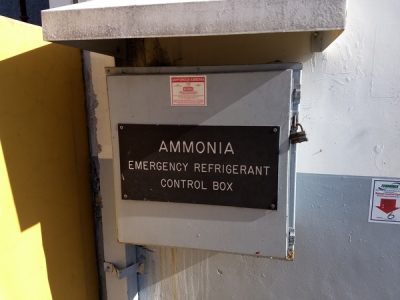RAGAGEP: Historical Variants and the Importance of IIAR Standards | Part 4: Emergency Shutdown Controls

Uriah Donaldson, OHST, presented a technical paper at the 2019 RETA National Conference and 2021 IIAR National Conference titled RAGAGEP: Historical Variants and the Importance of IIAR Standards.
This is the fourth post in a series of blogs which include excerpts from his technical paper.
Emergency Shutdown Controls
Like we will see throughout this section with multiple subjects, an initial requirement is often picked up by other code and standard documents and over many years that same requirement will evolve as safer technologies are developed. Regarding emergency shutdown controls, we first see the language for an emergency control switch in the 1967 Uniform Mechanical Code. These requirements were straightforward and left little room for misinterpretation:
A readily accessible single emergency refrigeration control switch shall be provided to shut off all electrically operated machinery in any machinery room, except the exhaust ventilation system complying with Section 1508. Such a switch shall be controlled from a point outside of, and within ten feet (10′) of the required opening to the machinery room it serves.[1]
In 1982 the evolution of the emergency shutdown requirement began when the Uniform Fire Code specified that the switch should be located “within the Emergency Control Box.”[2] This meant that in order to also comply with the UMC, the emergency control box would need to be located within ten feet of the machinery room entrance.
In 1994 the Uniform Mechanical and Fire Codes further required the switch to be “of the break-glass type” and the emergency shutoff should be interlocked with the detection system to automatically activate at 25% of the LFL (i.e., 40,000 ppm for ammonia). Additionally, the location of the emergency switch was to be located “immediately adjacent to and outside of each refrigeration machinery room exit” [emphasis mine].[3] For facilities under the jurisdiction of states which adopted codes published by the International Code Council starting in 2000, namely the International Fire Code and Mechanical Code, only a single emergency switch was required to be located at an “approved location immediately outside the machinery room and adjacent to its principal entrance.”[4] Furthermore, the requirement for interlocking the emergency switch with the detection and automatic shutdown at 25% of the LFL was not adopted until 2009 by the IFC, and 2012 by the IMC respectively.[5] Regarding the location of the emergency switch, the Uniform Fire and Mechanical Codes would continue to require an emergency switch “outside of each refrigeration machinery room exit” until 2009 and 2012 respectively.[6]
In 2014 ANSI/IIAR 2 was updated to better align with the mechanical and fire codes. One of the additions made was that automatic emergency shutdown controls be activated at 25% of the LFL (or the ammonia detector’s upper limit).[7]
Emergency Pressure Control System vs Emergency Control Box
The idea behind the Emergency Control Box (also called a Fire Dump Box) was in code documents for many years before the general time period we are studying in this paper (i.e., the first major publication of IIAR 2 in the early 1970s). In 1973 the Uniform Mechanical Code maintained the same language from earlier versions requiring, “Every refrigerating system located in a building and containing… a Group 2 refrigerant shall be equipped with means for manual discharge of the refrigerant to the atmosphere.”[8]
In 1982 the first requirement for removing ammonia refrigerant “in the event of an emergency” appeared in the Uniform Fire Code. At this time, the UFC did not specify that an emergency control box configuration had to be installed, choosing instead to require that it must be “an approved system.”[9]
In 2006, both Fire Codes (NFPA 1 and IFC), along with the International Mechanical Code, acknowledged there were new and better ideas than discharging ammonia systems during an emergency and therefore replaced the requirement of the antiquated emergency control box with an automated “emergency pressure control system.”[10] This new system would activate during over-pressurization to relieve pressure from the high side of the system to the low side of the system, thus reducing the likelihood of a lifted relief valve.
[1] 1967 UMC §1509 Equipment in a Machinery Room
[2] 1982 UFC §63.108(a)(5)(iv) Control Valves
[3] 1994 UMC §1108.4 Emergency Control; 1994 UFC §6314.4 Emergency Control
[4] 2000 IFC §606.9 Remote Controls
[5] 2009 IFC §606.9.1 Refrigeration System Emergency Shutoff; 2012 IMC §1106.5.1 Refrigeration System Emergency Shutoff
[6] 2009 NFPA 1 §53.2.3.4.5; 2012 UMC §1109.4 Emergency Control
[7] ANSI/IIAR 2-2014 §6.13.2.4
[8] 1973 UMC §1518(a) Manual Discharge or Refrigerant
[9] 1982 UFC §63.108(a) Emergency Ammonia Diffusion Systems
[10] 2006 NFPA 1 §53.7; 2006 IMC §1105.9; 2006 IFC §606.10
The previous blogs are available in the following links:
- Part 1: Introduction
- Part 2: Defining RAGAGEP and Historical Perspectives
- Part 3: The IIAR’s Vision for the Future

Leave a Reply